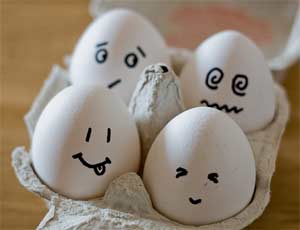Recomb - Review
 If two genes are linked, they are on the same chromosome. Because the two chromatids of the
chromosomes are mirror images of each other, we can indicate linked genes like this: AB/ab, where the letters before the slash indicate the alleles on one chromatid, and the letters
after the slash indicate the alleles on the other chromatid. (It's important that each gene
is represented on each chromatid, and in the same order).
If two genes are linked, they are on the same chromosome. Because the two chromatids of the
chromosomes are mirror images of each other, we can indicate linked genes like this: AB/ab, where the letters before the slash indicate the alleles on one chromatid, and the letters
after the slash indicate the alleles on the other chromatid. (It's important that each gene
is represented on each chromatid, and in the same order).
If the chromatids always stayed 'whole' during meiosis, then there would be only 2 gamete types for a given genotype, rather than the four that we usually expect when two genes are involved. One gamete type would be the alleles before the slash, and the other would be the alleles after the slash.
Because chromatids break apart and recombine, there are also 'recombinant' gametes which have one allele from each chromatid (one from each side of the slash).
The recombination frequency tells you how often chromatids break apart. If the recombination frequency is x, then each of the two recombinant gametes will appear with a frequency (probability) of (x/2)%.
In two linked genes with recombination, the phenotypic ratios we expect (i.e., 9:3:3:1 for a dihybrid cross) do not happen. Finding the frequency of a phenotype works like this:
- Draw a punnett square.
- Determine all row-column combinations that lead to the desired phenotype.
- For each combination, multiply the probability of the row by the probability of the column (Law of AND).
- Add up all the products (Law of OR).
The frequency of recombination (cross-over) depends on how far apart the genes are on the chromosome, which is measured in map units. One map unit = 1% chance of crossover. If you know the map units between 3 pairs of genes, you can determine the order of the genes on the chromosome.
The farther apart the genes are, the more they act like they're unlinked. At the extreme, a cross-over rate of 0% would mean the genes never recombine, while a cross-over rate of 50% means that the genes cannot be distinguished from unlinked genes, because each gamete occurs 25% of the time.
 To test whether two genes are linked, you FIRST need to test whether each gene assorts
independently. For example, if you have a dihybrid cross (AaBb x AaBb), then when you
aggregate the A phenotypes vs. the a phenotypes, you should have a 3:1 ratio. This can be
tested with a chi-square (1 degree of freedom). If each gene does not assort independently,
then you can't make predictions about the combined phenotypic ratio, and you can't test whether
the genes are linked (NOTE: this is not the same as proving the genes are not linked -- its
just an admission of defeat, because you can't prove anything one way or the other). If the
initial tests of independent assortment work, then you can go on to test the combined phenotypic
ratios, which in the case of a dihybrid cross should be 9:3:3:1, using a chi-square. If the test
shows that the observed ratio is different, then you have evidence suggesting the genes are linked.
To test whether two genes are linked, you FIRST need to test whether each gene assorts
independently. For example, if you have a dihybrid cross (AaBb x AaBb), then when you
aggregate the A phenotypes vs. the a phenotypes, you should have a 3:1 ratio. This can be
tested with a chi-square (1 degree of freedom). If each gene does not assort independently,
then you can't make predictions about the combined phenotypic ratio, and you can't test whether
the genes are linked (NOTE: this is not the same as proving the genes are not linked -- its
just an admission of defeat, because you can't prove anything one way or the other). If the
initial tests of independent assortment work, then you can go on to test the combined phenotypic
ratios, which in the case of a dihybrid cross should be 9:3:3:1, using a chi-square. If the test
shows that the observed ratio is different, then you have evidence suggesting the genes are linked.
If you want a printer-friendly version of this module, you can find it here in a Microsoft Word document. This printer-friendly version should be used only to review, as it does not contain any of the interactive material, and only a skeletal version of problems solved in the module.
Copyright University of Maryland, 2007
You may link to this site for educational purposes.
Please do not copy without permission
requests/questions/feedback email: mathbench@umd.edu